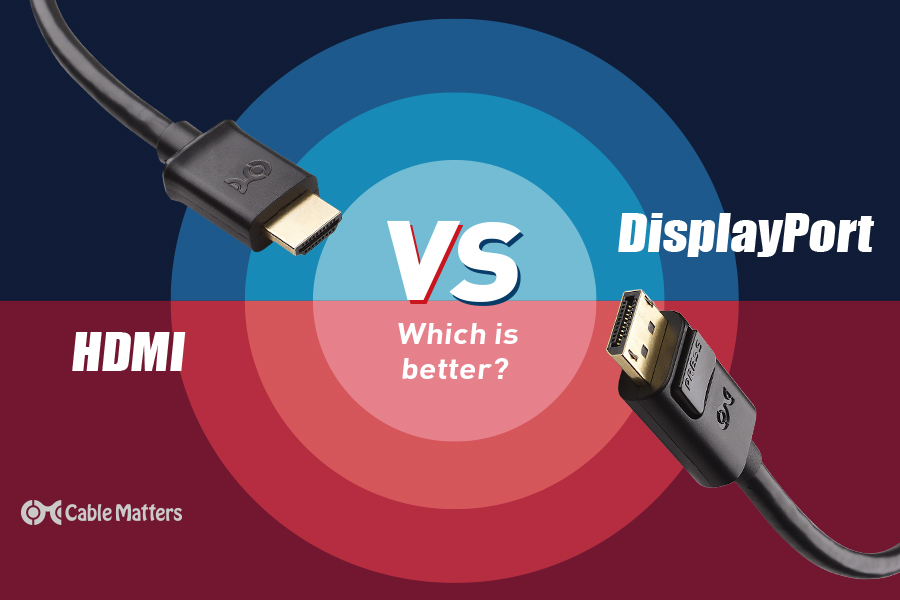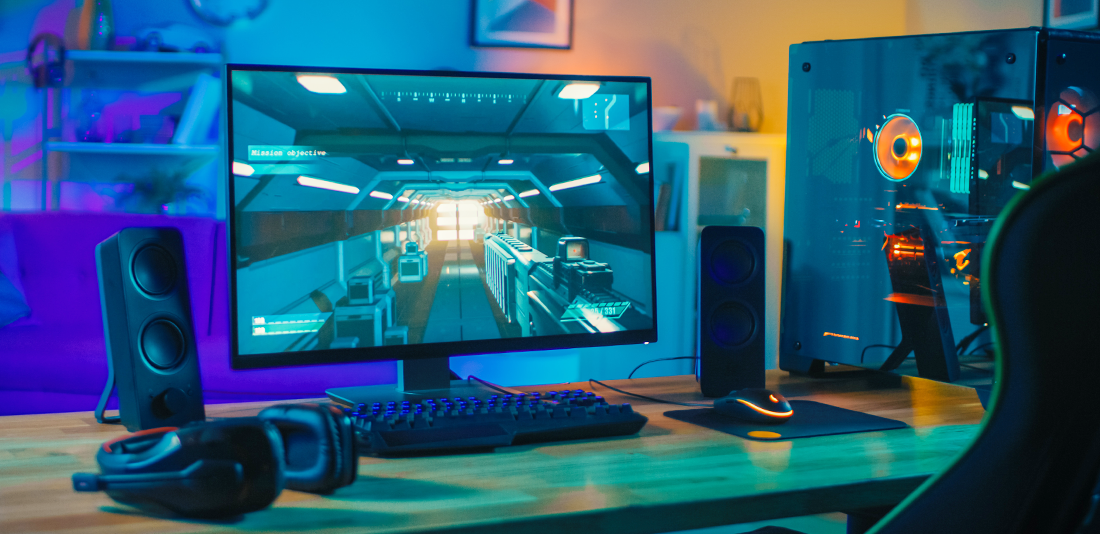
The two most popular cables for connecting source devices like game consoles, desktop computers, Blu-ray players, and set-top boxes to monitors and TVs are DisplayPort and HDMI. They’ve both been the most popular solutions for well over a decade too, and the latest generations of each connector type are unlikely to change that. They offer support for the latest and greatest specifications and features, including both 4K and 8K resolution, high refresh rates, a range of HDR standards, and 10-bit color, as well as compression technologies like display stream compression and chroma subsampling.
But as much as HDMI and DisplayPort cables share a number of impressive capabilities, there are some distinct differences between them. Depending on which generations you compare, the performance differences (along with supported resolutions and refresh rates) can be quite stark, and there are some features which are exclusives of one cable type or another.
These differences have fostered friendly competition between the two cable standards over the past decade or more, but outside of gentle competitiveness, there are very real reasons to pick one connector or cable over another. Gamers who have a graphics card with both DisplayPort and HDMI connectors may well ask, 'Is DisplayPort better than HDMI?'
Console gamers may just wonder what all the fuss is about, with HDMI being their only connection option. But these cables don’t just offer benefits for those looking for entertainment. Professionals should well consider DisplayPort vs. HDMI for their work machines, too.
After years of back and forth and feature leapfrogs, the DisplayPort vs. HDMI debate is far from settled. Let’s take a deep dive into what makes these two cable types so useful, and why you might want to pick one over the other.
Comparing Connectors: DisplayPort vs. HDMI
One of the most apparent differences between HDMI and DisplayPort connectors is the connector shape and size itself. The standard Type A HDMI connector has 19 pins and is vertically symmetrical, making it only possible to plug it in one way. This might feel slightly antiquated in a world increasingly dominated by reversible USB-C connections and cables, but non-reversible connectors have been far more commonplace for far longer.
There are rarer Mini and Micro HDMI connectors too. They’re physically much smaller but utilize the same 19 pins (albeit, with a different layout).
The standard DisplayPort connector features 20 pins and is largely rectangular, with one notched corner guaranteeing correct orientation. That means it too, is not reversible and its nearly symmetrical connector can occasionally make it tricky to plug in if you don’t have a clear view of its orientation. To make sure it stays still once you do get it plugged in, though, DisplayPort features small hooks that help hold any connected cables in place, requiring a button press to remove them.
It also comes in miniature form, featuring the same pin count, but in a small form factor. Although it originally featured prominently on Apple MacBooks and on some monitors as part of Intel’s early generation Thunderbolt designs, Mini Displayport is much less common today, with manufacturers of new devices preferring USB-C instead.
Standard DisplayPort vs HDMI Port:
.jpg)
Wikipedia
In general, HDMI connectors are found more commonly on living room devices and TVs – and is often the only video input available on modern high-end TVs. You will also find a single HDMI port on most desktop computers and some high-end laptops. DisplayPort, on the other hand, is more commonplace on desktop PCs and laptops. That makes the DisplayPort vs. HDMI gaming debate largely centered around where you want to play. With a gaming console in your lounge? HDMI is likely the better choice. On a desktop PC with a monitor? DisplayPort will be more readily available and likely capable.
DisplayPort vs. HDMI: Bandwidth & Speed
At a fundamental level, DisplayPort and HDMI achieve the same goal. They're a singular cable that can transfer both audio and video connections from a source to a display, with support for high resolutions and refresh rates. There have been many versions of both connectors over the years, with standards regularly leapfrogging each other as bandwidth improved to support higher resolutions and frame rates, new features, and advanced compression technologies.
The difference between DisplayPort and HDMI very much depends on which versions you're discussing. The two most commonly available standards are DisplayPort 1.4, and HDMI 2.0, although that’s starting to change following the debut of both standards’ next-generation specifications. Both HDMI 2.1 and DisplayPort 2.0/2.1 are now readily available with supporting source devices and displays.
You'll find more devices that support HDMI than DisplayPort, but in this context the answer to the question 'Is DisplayPort better than HDMI' is, emphatically, yes – although it does does depend on what kind of devices you’re looking to connect. Some displays, especially TVs, tend to only offer HDMI. DisplayPort can work with an adapter or converter, but even with its greater on-paper performance, it may not always be the best solution.
HDMI 2.0 supports a maximum bandwidth of 18 Gbps, which is enough to handle 4K resolution at up to 60Hz, or 1080p at up to 240Hz. In comparison, DisplayPort 1.4 has a maximum bandwidth of 32.4Gbps, which opens up a much greater resolution and frame rate potential. It supports 4K resolution at up to 120Hz without compression, and 8K resolution at 30Hz – something HDMI 2.0 can't manage, even with reduced chroma subsampling.
That paradigm flipped in 2023, however, as more devices and displays begin to support the new, HDMI 2.1 Standard, which makes DisplayPort vs. HDMI gaming comparisons far more intriguing.
HDMI 2.1 more than doubles the maximum bandwidth to 48Gbps, and thanks to a much more efficient encoding scheme, it has a maximum data rate of 42Gbps. That opens up support for 4K resolution at 144Hz or 8K at 30Hz – and far more if you employ Display Stream Compression (DSC). The most impactful aspect of HDMI 2.1, however, has been in its support of higher refresh rate console gaming. Both the Xbox Series X/S and PlayStation 5 support 4K 120Hz gaming in certain games, and with an HDMI 2.1 connection gamers can take full advantage of that on TVs that also support that resolution and refresh rates.
For PC gamers, the latest generation graphics cards from Nvidia and AMD (RTX 3000/4000 and RX 6000/7000) have HDMI 2.1 ports on them, so are ready to take full advantage of it. In the case of Nvidia graphics cards, this may be the better choice, since even though they also come equipped with DisplayPort connections, they are only DisplayPort 1.4, which doesn’t offer the same bandwidth as HDMI 2.1
However, AMD’s RX 7000 graphics cards were the first to offer a DisplayPort 2.1 connection – and not just one, three of them! DisplayPort 2.1 is effectively the same as DisplayPort 2.0, with some mild updates to the specification. Performance is identical, and equally extreme in each case.
DisplayPort 2.1 has a maximum total bandwidth of 80 Gbps, with a maximum total data rate of 77.37 Gbps. This comes as part of three new transmission modes, which not all DisplayPort 2.1 cables and connections can and will support. The base performance is around that of HDMI 2.1, with a total bandwidth of 40 Gbps with 10 Gbps per lane, while others will support a 13.5 Gbps rate per lane, and up to 20 Gbps with the most capable DisplayPort 2.1 connections.
DisplayPort 2.1 officially supports up to 4K 240Hz without any form of compression, or 8K at up to 60Hz – with Display Stream Compression and Chroma Subsampling allowing it to go even further. Theoretically, with DSC it could manage a single 16K display with 10-bit color and HDR, or twin 8K displays at 120Hz.

In its original unveiling of these new graphics cards, AMD highlighted that technically DisplayPort 2.1 can manage up to 480Hz at 4K and 900Hz at 1080p – highlighting the tantalizing potential of such fast displays for competitive gamers. However, in reality, no displays that can support such specifications exist, with a handful only now starting to support 4K at 240Hz and 1080p at 500Hz.
Features & Benefits of DisplayPort and HDMI
In the DisplayPort vs. HDMI head-to-head, there aren't just differences in bandwidth and connector, but differences in features too. One of the key ones is ARC and EARC technologies. Enjoyed by HDMI standards since HDMI 1.4, it enables the two-way processing of audio data, thereby allowing for a daisy chain of A/V equipment, source, and display, cutting back on cable waste and enhancing the bandwidth of the audio connection over competing standards like S/PDIF and optical.
HDMI 2.1 introduced support for eARC, which utilized the additional data rate of the new standard to add support for uncompressed 5.1 and 7.1 surround sound, as well as support for 3D sound technologies like Dolby Atmos and DTS:X.
DisplayPort has found great success as an adopted standard, outside of its main connector. It's included in Thunderbolt and USB-C connections, enabling video transmission over those alternative cables and ports – all of which are available in the Cable Matters store.
DisplayPort 2.1 introduced improved data transmission over USB-C cables. It also brought with it a new naming convention for DisplayPort cables, with some now sporting DP40 and DP80 labeling, which denotes their ability to offer 40 Gbps of data rate, or 80 Gbps, respectively.
Both HDMI and DisplayPort standards support variable refresh rates, but where DisplayPort supports both AMD's Freesync and Nvidia's G-Sync, HDMI only supports the former in older standards like HDMI 2.0, and HDMI 1.4. However, the latest generation HDMI 2.1 does offer support for G-Sync.
You can run a DisplayPort cable for longer than its HDMI counterparts too, with passive DisplayPort options maxing out around 5 meters before attenuation becomes a problem. In comparison, the latest HDMI 2.1 cables will run into problems around three meters. Active alternatives can extend that to 15 meters for both standards using fiber optic transmission techniques.
DisplayPort vs. HDMI: The Future of Audio and Video
Both DisplayPort and HDMI continue to be widely used display interfaces with their own unique advantages and features. DisplayPort 2.1 and HDMI 2.1 are the latest versions of each standard, offering various improvements.
DisplayPort 2.1 provides an even higher maximum bandwidth compared to HDMI 2.1, allowing for higher resolutions and refresh rates. Without Compression, it supports resolutions up to 10K at 60Hz delivering smooth and detailed visuals for gaming and multimedia applications. With DSC, DisplayPort 2.1 can support up to a single 16K @at 60Hz monitor. Additionally, DisplayPort 2.1 enables the use of Multi-Stream Transport (MST) technology, enabling the daisy-chaining of multiple monitors for enhanced productivity and flexibility. DisplayPort 2.1 supports dual 4K at 144hz monitors. On the other hand, HDMI 2.1 supports a single 8K at 60Hz and 4K at 144Hz, catering to the growing demand for higher resolutions and smoother graphics. It also offers features like Dynamic HDR, which enhances the color and contrast of supported content, providing a more lifelike viewing experience. HDMI 2.1 supports Variable Refresh Rate (VRR), including AMD FreeSync and NVIDIA G-SYNC, for tear-free gaming and reduced input lag.
When deciding between DisplayPort and HDMI, it is important to consider the specific requirements and use cases. DisplayPort may be preferable for gaming enthusiasts and professionals who demand high refresh rates and multi-monitor setups. HDMI, on the other hand, remains a popular choice for consumer electronics and home theaters due to its broad compatibility.
Both DisplayPort and HDMI continue to evolve and offer distinct advantages. The choice between them depends on individual needs, preferences, and the specific application or device.